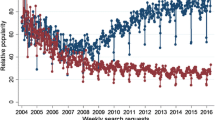Abstract
While scientometrics is now an established field, there are challenges. A closer look at how scientometricians aggregate building blocks into artfully made products, and point-represent these (e.g. as the map of field X) allows one to overcome the dependence on judgements of scientists for validation, and replace or complement these with intrinsic validation, based on quality checks of the several steps. Such quality checks require qualitative analysis of the domains being studied. Qualitative analysis is also necessary when noninstitutionalized domains and/or domains which do not emphasize texts are to be studied. A further challenge is to reflect on the effects of scientometrics on the development of science; indicators could lead to ‘induced’ aggregation. The availability of scientometric tools and insights might allow scientists and science to become more reflexive.
Similar content being viewed by others
References
W. Glänzel, U. Schoepflin, Little scientometrics, big scientometrics—and beyond,Scientometrics, 30 (1994) 375–384.
B. R. Martin, J. Irvine, Evaluating the evaluators: A reply to our critics,Social Studies of Science, 15 (1985) 558–575.
A. Rip,Wetenschap als Mensenwerk, Ambo, Baarn, 1978.
P. Healey, H. Rothman, P. K. Hoch, An experiment in science mapping for research planning,Research Policy, 15 (1986) 233–251.
S. Woolgar, Beyond the citation debate: towards a sociology of measurement technologies and their use in science policy,Science and Public Policy, 18 (1991) No. 5, 319–326.
M. Callon, J. Law, A. Rip,Mapping the Dynamics of Science and Technology, Macmillan, London, 1986.
B. R. Martin, J. Irvine, Assessing basic research: Some partial indicators, of scientific progress in radio astronomy,Research Policy, 12 (1983) 61–90.
O. Amsterdamska, L. Leydesdorff, Citations: Indicators of significance?,Scientometrics, 15 (1989) 449–471.
J. L. Penick Jr., C. W. Pursell Jr., M. B. Sherwood, D. C. Swain, The Politics of American Science, 1939 to the Present (Revised Edition), MIT Press, Cambridge, Mass., 1972.
L. Leydesdorff, Problems with the ‘measurement’ of national scientific performance,Science and Public Policy, 15 (1988) 149–152.
J. Anderson, P. M. D. Collins, J. Irvine, P. A. Isard, B. R. Martin, F. Narin, K. Stevens, On-line approaches to measuring national scientific output—A cautionary tale,Science and Public Policy, 15 (1988) 153–161.
J. Irvine, B. Martin, T. Peacock, R. Turner, Charting the decline of British science,Nature, 316 (1985) 587–590.
B. R. Martin, British science in the 1980s—Has the relative decline continued?,Scientometrics, 29 (1994) 27–57.
G. N. Gilbert, Referencing as persuasion,Social Studies of Science, 7 (1977) 113–122.
A. Rip, Mapping of science: Possibilities and limitations, in:A. F. J. Van Raan (Ed.),Handbook of Quantitative studies of Science and Technology, Elsevier Science Publishers, Amsterdam, 1988, p. 253–273.
R. Whitley,The Intellectual and Social Organisation of the Sciences, Oxford, Clarendon Press, 1984.
D. H. White, D. Sullivan, E. J. Barboni, The interdependence theory and experiment in revolutionary science: The case of parity violation,Social Studies of Science, 9 (1979) 303–327.
A. J. Nederhof, R. F. Meijer, Development of bibliometric indicators for utility of research to users in society: measurement of external knowledge transfer via publications in trade journals,Scientometrics, 32 (1995) 37–48.
C. Le Pair, The citation gap of applicable science, in:A. F. J. Van Raan, (Ed.),Handbook of Quantitative Studies of Science and Technology, Elsvier Science Publishers, Amsterdam, 1988, p. 537–553.
B. Latour, S. Woolgar,Laboratory Life, Sage, Beverly Hills, Cal., 1979.
A. Rip, The Republic of Science in the 1990s,Higher Education, 28 (1994) 3–23.
W. E. Snizek, Comment on Nicolini et al.,Scientometrics, 32 (1995) 117–120.
W. B. Arthur, Competing technologies, increasing returns and lock-in by historical events,Economic Journal, 99 (1989) 116–131.
M. Dahl, S. Lahlou, Measurement of network effects from the EC Science/Stimulation Programmes,Scientometrics, 21 (1991) 325–342.
Author information
Authors and Affiliations
Rights and permissions
About this article
Cite this article
Rip, A. Qualitative conditions of scientometrics: The new challenges. Scientometrics 38, 7–26 (1997). https://doi.org/10.1007/BF02461120
Received:
Issue Date:
DOI: https://doi.org/10.1007/BF02461120



